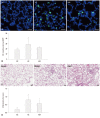Long-term (postnatal day 70) outcome and safety of intratracheal transplantation of human umbilical cord blood-derived mesenchymal stem cells in neonatal hyperoxic lung injury
- PMID: 23364976
- PMCID: PMC3575965
- DOI: 10.3349/ymj.2013.54.2.416
Long-term (postnatal day 70) outcome and safety of intratracheal transplantation of human umbilical cord blood-derived mesenchymal stem cells in neonatal hyperoxic lung injury
Abstract
Purpose: This study was performed to evaluate the long-term effects and safety of intratracheal (IT) transplantation of human umbilical cord blood-derived mesenchymal stem cells (hUCB-MSCs) in neonatal hyperoxic lung injury at postnatal day (P)70 in a rat model.
Materials and methods: Newborn Sprague Dawley rat pups were subjected to 14 days of hyperoxia (90% oxygen) within 10 hours after birth and allowed to recover at room air until sacrificed at P70. In the transplantation groups, hUCB-MSCs (5×10⁵) were administered intratracheally at P5. At P70, various organs including the heart, lung, liver, and spleen were histologically examined, and the harvested lungs were assessed for morphometric analyses of alveolarization. ED-1, von Willebrand factor, and human-specific nuclear mitotic apparatus protein (NuMA) staining in the lungs and the hematologic profile of blood were evaluated.
Results: Impaired alveolar and vascular growth, which evidenced by an increased mean linear intercept and decreased amount of von Willebrand factor, respectively, and the hyperoxia-induced inflammatory responses, as evidenced by inflammatory foci and ED-1 positive alveolar macrophages, were attenuated in the P70 rat lungs by IT transplantation of hUCB-MSCs. Although rare, donor cells with human specific NuMA staining were persistently present in the P70 rat lungs. There were no gross or microscopic abnormal findings in the heart, liver, or spleen, related to the MSCs transplantation.
Conclusion: The protective and beneficial effects of IT transplantation of hUCB-MSCs in neonatal hyperoxic lung injuries were sustained for a prolonged recovery period without any long-term adverse effects up to P70.
Conflict of interest statement
The authors have no financial conflicts of interest.
Figures





Similar articles
-
Timing of umbilical cord blood derived mesenchymal stem cells transplantation determines therapeutic efficacy in the neonatal hyperoxic lung injury.PLoS One. 2013;8(1):e52419. doi: 10.1371/journal.pone.0052419. Epub 2013 Jan 21. PLoS One. 2013. PMID: 23349686 Free PMC article.
-
Human umbilical cord blood-derived mesenchymal stem cells attenuate hyperoxia-induced lung injury in neonatal rats.Cell Transplant. 2009;18(8):869-86. doi: 10.3727/096368909X471189. Epub 2009 Apr 9. Cell Transplant. 2009. PMID: 19500472
-
Optimal Route for Human Umbilical Cord Blood-Derived Mesenchymal Stem Cell Transplantation to Protect Against Neonatal Hyperoxic Lung Injury: Gene Expression Profiles and Histopathology.PLoS One. 2015 Aug 25;10(8):e0135574. doi: 10.1371/journal.pone.0135574. eCollection 2015. PLoS One. 2015. PMID: 26305093 Free PMC article.
-
Intratracheal transplantation of mesenchymal stem cells simultaneously attenuates both lung and brain injuries in hyperoxic newborn rats.Pediatr Res. 2016 Sep;80(3):415-24. doi: 10.1038/pr.2016.88. Epub 2016 Apr 11. Pediatr Res. 2016. PMID: 27064241
-
Intratracheal transplantation of human umbilical cord blood-derived mesenchymal stem cells dose-dependently attenuates hyperoxia-induced lung injury in neonatal rats.Cell Transplant. 2011;20(11-12):1843-54. doi: 10.3727/096368911X565038. Cell Transplant. 2011. PMID: 23167961
Cited by
-
The Potentials and Caveats of Mesenchymal Stromal Cell-Based Therapies in the Preterm Infant.Stem Cells Int. 2018 Apr 8;2018:9652897. doi: 10.1155/2018/9652897. eCollection 2018. Stem Cells Int. 2018. PMID: 29765429 Free PMC article. Review.
-
Intratracheal transplantation of mesenchymal stem cells attenuates hyperoxia-induced lung injury by down-regulating, but not direct inhibiting formyl peptide receptor 1 in the newborn mice.PLoS One. 2018 Oct 24;13(10):e0206311. doi: 10.1371/journal.pone.0206311. eCollection 2018. PLoS One. 2018. PMID: 30356317 Free PMC article.
-
The bone marrow of mouse-rat chimeras contains progenitors of multiple pulmonary cell lineages.Front Cell Dev Biol. 2024 Apr 17;12:1394098. doi: 10.3389/fcell.2024.1394098. eCollection 2024. Front Cell Dev Biol. 2024. PMID: 38694819 Free PMC article.
-
Ex vivo expanded human cord blood-derived hematopoietic progenitor cells induce lung growth and alveolarization in injured newborn lungs.Respir Res. 2013 Mar 23;14(1):37. doi: 10.1186/1465-9921-14-37. Respir Res. 2013. PMID: 23522153 Free PMC article.
-
Stem cells for bronchopulmonary dysplasia in preterm infants: A randomized controlled phase II trial.Stem Cells Transl Med. 2021 Aug;10(8):1129-1137. doi: 10.1002/sctm.20-0330. Epub 2021 Apr 20. Stem Cells Transl Med. 2021. PMID: 33876883 Free PMC article. Clinical Trial.
References
-
- Bhandari A, Panitch HB. Pulmonary outcomes in bronchopulmonary dysplasia. Semin Perinatol. 2006;30:219–226. - PubMed
-
- Bland RD. Neonatal chronic lung disease in the post-surfactant era. Biol Neonate. 2005;88:181–191. - PubMed
-
- Avery ME, Tooley WH, Keller JB, Hurd SS, Bryan MH, Cotton RB, et al. Is chronic lung disease in low birth weight infants preventable? A survey of eight centers. Pediatrics. 1987;79:26–30. - PubMed
-
- Bregman J, Farrell EE. Neurodevelopmental outcome in infants with bronchopulmonary dysplasia. Clin Perinatol. 1992;19:673–694. - PubMed
-
- Chang YS, Choi SJ, Sung DK, Kim SY, Oh W, Yang YS, et al. Intratracheal transplantation of human umbilical cord blood-derived mesenchymal stem cells dose-dependently attenuates hyperoxia-induced lung injury in neonatal rats. Cell Transplant. 2011;20:1843–1854. - PubMed
Publication types
MeSH terms
Substances
LinkOut - more resources
Full Text Sources
Other Literature Sources
Medical
Research Materials
Miscellaneous

